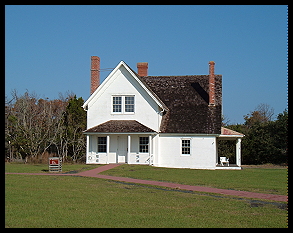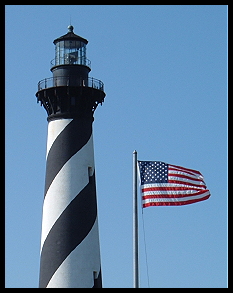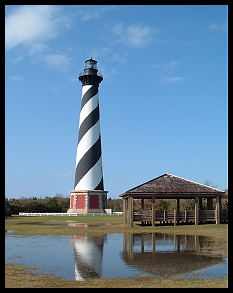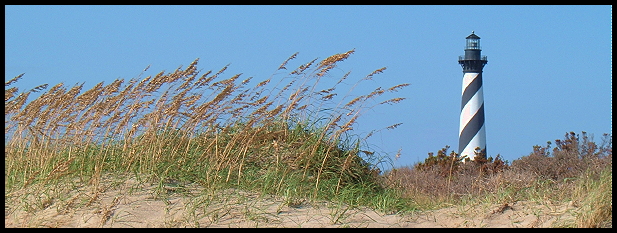Once the fledgling United States won its independence from Great Britain in 1776, the young nation began building lighthouses to help guide mariners along the coast. The narrow barrier islands of coastal North Carolina, known as the Outer Banks, have long posed serious hazards to mariners. Just off shore from Cape Hatteras lies probably the most formidable of navigational hazards found along the east coast. Diamond Shoals, formed by the near collision of the northbound Gulf Stream and the southbound Labrador Current, has become known as the “Graveyard” of the Atlantic, due to the number of ships that have ended their days on its shoals.
With important goods and lives being lost, Alexander Hamilton petitioned Congress in 1792 to build a lighthouse at Cape Hatteras. Finally, in 1803, Henry Dearborn constructed a 90-foot sandstone tower. The lighthouse was fitted with an iron chandelier that stood 12 feet in height and held 18 whale-oil lamps. The new lighthouse, built to serve as the nations first “warning light,” failed to effectively warn sailors of the nearby dangers.
Even though the lighthouse was inefficient, improvements were not made to the lighthouse until 1854. Then an additional sixty feet were added to the tower, which raised the focal plane of the light to 150 feet. A first order Fresnel lens replaced the inefficient lamp system in the original lantern room, and greatly intensified the light and improved its ability to mark the shoals. A double keepers' quarters was also added to the light station at this time. While the improvements to the light station helped to effectively mark Diamond Shoals, it was quickly noted that the lighthouse was in a struggle against nature for its survival.
After fighting a loosing battle with the wind, the twenty-foot high sand dune that the lighthouse was perched upon was badly eroded to the point that the lighthouse was deemed to have an unstable foundation. The Lighthouse Board opted to replace the current lighthouse.
Dexter Stetson, a builder from New England, was contracted to oversee the construction of the new lighthouse. The plan for the new lighthouse called for an innovative solution to prevent the new tower from suffering the fate of the 1803 tower. Construction crews dug a large hole and laid a series of yellow pine planks to act as the foundation. Cut granite stone, bricks, ironwork for the stairs, and an iron lantern to house the lens were brought to the site to construct the lighthouse. Two years later, in 1870, work was completed on the tower. The result was a black and white spiral-stripped lighthouse with an overall height of 208 feet, allowing the focal plane of the light to soar an amazing 180 feet above the beach. The lofty height of the tower combined with the light focusing power of the first order Fresnel lens enabled the light to reach twenty miles out over the Atlantic, far enough to be an effective warning to mariners navigating the waters nearby.
The new lighthouse continued to warn sailors of the nearby shoals, but the waves of the ocean continued to erode sand from the beach, drawing the ocean waves closer and closer to the tower's foundation. Attempts to control the erosion began in the early 1930’s, but to no avail. The decision was made to move the light to a nearby skeleton tower after it was closed in 1936. It wasn’t until the formation of the Cape Hatteras National Seashore that the possibility of returning the light to the lighthouse was realized. Working with the Coast Guard, the National Park Service was able to get the light moved back into the brick tower in 1950, even with continued erosion threatening the foundation of the grand tower.
The National Academy of Sciences made a recommendation to the National Park Service that the tower be moved to protect it from the eroding shoreline. After a restoration of the tower with a price tag of more than one million dollars, the lighthouse was fit to be moved. Finally, in 1999, the 3,000-ton lighthouse was moved an amazing 2,900 feet to the southwest, creating a 1,600 feet buffer from the ocean. Along with the tower, the double keepers' quarters, assistant keeper's quarters, and the oil house were moved as well. Once everything was safely moved into place, the lighthouse was relit on November 13, 1999. Its two modern aerobeacons emit a white “flash” every 7.5 seconds. The tower was later reopened to the public to climb and enjoy the wonderful view from the exterior gallery. But it wasn’t long before the tower would be closed due to fears concerning the structural integrity of the cast iron staircase. NPS officials went to work repairing the 268-step staircase. Once restoration work was completed, the tower was reopened.
Today, the tower is open for the public to enjoy. The assistant keeper's quarters and the double keepers' quarters are open to the public as well and the double keepers' quarters serves as a small museum. The lighthouse remains the tallest brick lighthouse and possibly the most well known and most recognizable lighthouse in the United States. This distinction draws thousands of visitors to the tower each year. For visiting and climbing information, please check the National Park Service's official website for the lighthouse or call 1-252-994-4474.
In this artist's rendering by Brent Westwood, both the 1803 and 1870 Cape Hatteras lighthouses are drawn to scale. When the 1870’s lighthouse was constructed and put into operation, the focal plane of the light was raised to 190 feet from the 140 feet of the 1803 tower. Raising the light an additional 50 feet made the 1870’s lighthouse more effective at marking Diamond Shoals.









